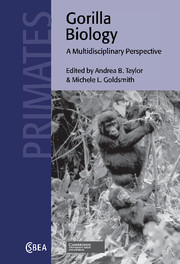Book contents
- Frontmatter
- Contents
- List of contributors
- Acknowledgments
- Epigraph
- Introduction: Gorilla biology: Multiple perspectives on variation within a genus
- Part 1 Gorilla taxonomy and comparative morphology
- Part 2 Molecular genetics
- Part 3 Behavioral ecology
- Part 4 Gorilla conservation
- 16 An introductory perspective: Gorilla conservation
- 17 The current status of gorillas and threats to their existence at the beginning of a new millennium
- 18 Distribution, taxonomy, genetics, ecology, and causal links of gorilla survival: The need to develop practical knowledge for gorilla conservation
- 19 The Cross River gorilla: Natural history and status of a neglected and critically endangered subspecies
- Afterword
- Index
- References
16 - An introductory perspective: Gorilla conservation
Published online by Cambridge University Press: 11 August 2009
- Frontmatter
- Contents
- List of contributors
- Acknowledgments
- Epigraph
- Introduction: Gorilla biology: Multiple perspectives on variation within a genus
- Part 1 Gorilla taxonomy and comparative morphology
- Part 2 Molecular genetics
- Part 3 Behavioral ecology
- Part 4 Gorilla conservation
- 16 An introductory perspective: Gorilla conservation
- 17 The current status of gorillas and threats to their existence at the beginning of a new millennium
- 18 Distribution, taxonomy, genetics, ecology, and causal links of gorilla survival: The need to develop practical knowledge for gorilla conservation
- 19 The Cross River gorilla: Natural history and status of a neglected and critically endangered subspecies
- Afterword
- Index
- References
Summary
To conserve a species we need to know the threats it faces, and the biology of its potential reaction to those threats. Many other areas of knowledge are necessary too, of course. But the threats and the biology are a start, and these are the topics of Plumptre et al.'s and Sarmiento's comprehensive chapters. Oates et al. complete the section with the equivalent of a worked example, a valuable description for one small population of the integration of survey work, natural history, biology, and conservation management.
Plumptre et al. describe the four horsemen of the conservation apocalypse as they affect gorillas – habitat loss and modification, hunting, disease, and war. Currently, the majority of gorillas, about 80% of them, live outside of protected areas (Harcourt, 1996). Although creation and maintenance of protected areas is one of the main means of conserving gorilla populations, Plumptre et al. also provide an enlightening account of how conservationists might help conservation outside protected areas by, for example, working in collaboration with logging companies. In other words, it is as often the biologists themselves, as much or more than their biological findings, that are important to conservation. The biologists are the ones in the wilderness more than is anyone else, and thus they are usually the first to see the problem, to warn of the problem, to substantiate the problem, and to stimulate action (Harcourt, 2000; Chapman and Peres, 2001).
- Type
- Chapter
- Information
- Gorilla BiologyA Multidisciplinary Perspective, pp. 407 - 413Publisher: Cambridge University PressPrint publication year: 2002

